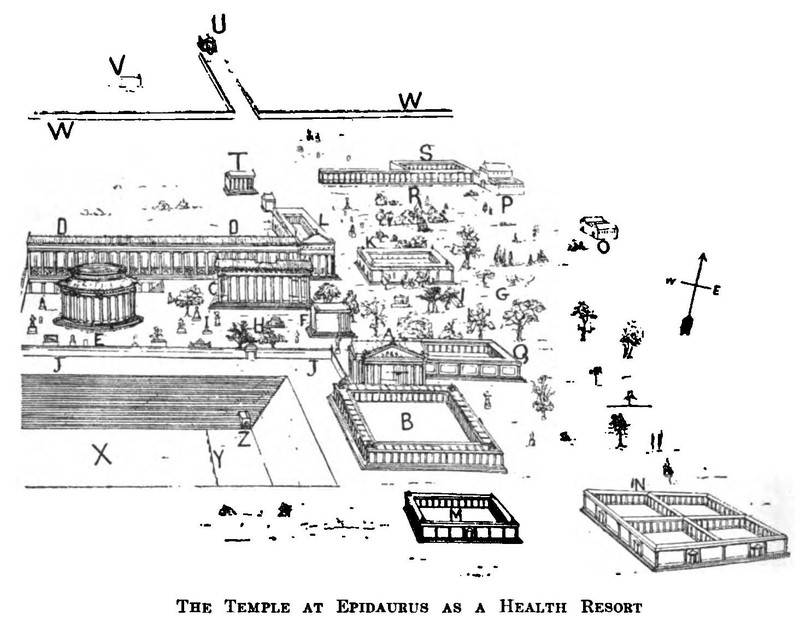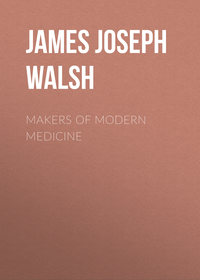 полная версия
полная версияPsychotherapy
FIRST PHYSICIAN
The first physician of whom we have any record was I-em-Hetep, who lived in the reign of King Tcsher of the third dynasty of Egypt, probably before 4000 B. C. Among his titles, besides that of Master of Secrets, was Bringer of Peace. He was looked up to as one who, when not able to cure physical ailments, did succeed in consoling and reassuring patients so as to make their condition much more bearable. Like others of the great early physicians, he was after his death worshiped as a god, a tribute which probably signifies that those who had been benefited by his ministrations felt that he must have been more than mortal.
The extent of the Egyptians' admiration for him will be appreciated from the fact that the step pyramid at Sakkara is said to have been built in his honor, though, as a rule, pyramids were erected only to honor kings or the very highest nobility. The extant statue of I-em-Hetep shows a placid-looking man with an air of beneficent wisdom, seated with a scroll on his knees. It produces the distinct impression, as may be seen from the illustration, that his patients must have trusted him thoroughly, since this is the memory of his personality that was transmitted to posterity. While he came to be looked upon as the medical divinity of the Egyptians, he was never represented with a beard, which is the token of the gods, or of mortals who have been really apotheosized. Evidently his devotees felt that it was the divine in his humanity which was the most prominent feature that they wished to honor. Among the Greeks AEsculapius, who had been merely a successful physician, came to be honored as a deity. When we recall the condition of therapeutics at that time, it is evident that man's appreciation of his power to console, even though he might not be able to heal, of his influence over men's minds in the midst of their sufferings, and the confidence that his presence inspired, were the real sources of their grateful recognition.
PSYCHOTHERAPY IN EGYPT
Among the Egyptians the first great development of medicine came among the priests. The two professions, the medical and priesthood, were one, and the temples were the hospitals of the time. We have stories of people traveling long distances to certain temples in the early days of Egypt and also of Greece. Often the sick slept in the temples and dreamed of ways by which they would be cured. The stories make one feel that somehow the sleep which came over them was not entirely natural and spontaneous, but must have been something like hypnotic sleep. As for the dreams, the suggestions of modern time given in the hypnotic condition seem to be the best indication that we have of what happened in those old days. Certain it is that the persuasion of the patient that he would get better, the influence of the diversion of mind consequent upon his journey and the regulation of life under new circumstances in the temple, with the repeated suggestions of the priests and of their various remedial measures, as well as those due to the fact that other patients around him were improving, all plainly show the place of psychotherapy at this time.
Much of the old-time therapy was in association with dreams supposed to have been in some way inspired. This was true at Epidaurus, at Kos, at Rome, at Lebene, at Athens, and at every place we know of where cures were worked in the olden times. To the modern mind it seems impossible that dreams should come so apropos unless they were in some way directed. The only explanation seems to be the use of suggestion, with the probable production of sleep resembling our modern hypnotic trance. Apparently the patient's attention was little directed to the origin of the suggestions received, but he remembered and benefited by them.
The most explicit testimony that we have to the antiquity of psychotherapeutics and to the employment of the influence of the minds of patients over their ailments in the olden time is in Pinel's "Nosographie philosophique" and in his "Traité médico-philosophique sur l'alienation mentale."
Pinel himself will be remembered as the great French psychiatrist who, confident that he could control most of them by mental influence, first dared to strike the chains from the insane in the asylums of Paris, at the end of the eighteenth century, when for more than a century they had been treated more barbarously than ever before in history. The passage makes clear that the writer himself, over a hundred years ago, was persuaded of the significance of the patient's mental attitude and of the value of mental treatment for many nervous and mental diseases:
An intimate acquaintance with human nature and with the character in general of melancholics must always point out the urgent necessity of forcibly agitating the system, of interrupting the chain of their gloomy ideas, and of engaging their interest by powerful and continuous impressions on their external senses. Wise regulations of this nature are considered as having constituted in part the celebrity and utility of the priesthood of ancient Egypt. Efforts of industry and of art, scenes of magnificence and of grandeur, the varied pleasures of sense, and the imposing influences of a pompous and mysterious superstition, were perhaps never devoted to a more laudable purpose. At both extremities of ancient Egypt, a country which was at that time exceedingly populous and flourishing, were temples dedicated to Saturn, whither melancholics resorted in crowds in quest of relief. The priests, taking advantage of their credulous confidence, ascribed to miraculous powers the effects of natural means exclusively. Games and recreations of all kinds were instituted in these temples. Beautiful paintings and images were everywhere exposed to public view. The most enchanting songs, and sounds the most melodious "took prisoner the captive sense." Flowery gardens and groves, disposed with taste and art, invited them to refreshment and salubrious exercise. Gaily decorated boats sometimes transported them to breathe, amidst rural concerts, the pure breezes of the Nile. Sometimes they were conveyed to its verdant Isles, where, under the symbols of some guardian deity, new and ingeniously contrived entertainments were prepared for their reception. Every moment was devoted to some pleasurable occupation, or rather a system of diversified amusements, enhanced and sanctioned by superstition. An appropriate and scrupulously observed regimen, repeated excursions to the holy places, preconcerted fêtes at different stages to excite and keep up their interest on the road, with every other advantage of a similar nature that the experienced priesthood could invent or command, were, in no small degree, calculated to suspend the influence of pain, to calm the inquietudes of a morbid mind, and to operate salutary changes in the various functions of the system.
The Temple at Epidaurus as a Health ResortThis gives some slight idea of the magnificent arrangement of this famous health resort of the Greeks in which every possible care was taken to influence the mind of the patient favorably and bring about his cure. The buildings of the Hieron or medical institution of Epidaurus were beautifully situated about six miles from the town of Epidaurus in picturesque scenery and the most healthful surroundings. There were a series of bathing houses for hydropathy. The abatons, lofty and airy sleeping chambers with their southern sides and open colonnade, are singularly like the open balconies of our tuberculosis sanatoria. Every occupation of mind was provided. There was a theatre that would seat over 10,000 people. Here the great classic Greek plays were given with fullest effect. There was a stadium seating about 12,000 people in which athletic events were witnessed, finally there was a hippodrome for alt sorts of amusements in which animals shared. Then there were the walks through the country, sheltered paths around the grounds for inclement weather, even tunnels for passage from one building to another and all the influence of religion, of suggestion, of contact with cultured priests thoroughly accustomed to dealing with all manner of patients. No wonder the place was popular and many cures effected.

A, South Propylaea; B, Gymnasium; C, Temple of Esculapius; DD, East and West Abatons (temple enclosures); E, Pholos; F, Temple of Artemis; G, Grove; H, Small Altar; I, Large Alter; J, South Boundary; K, Square (building); L, Baths of Esculapius; M, Gymnasium and Hostel; N, Four Quadrangles (for promenade and exercise); O, Roman Building; P, Roman Bath; Q, Portico of Cotys; R, Northeastern Colonnade; S, Northeastern Quadrangle; T, Temple of Aphrodite (?); U, Northern Propylaea, on the Road to Epidaurus; V, Roman Building; W, Northern Boundary; X, Stadium; Y, Goal or Starting Line; Z, Tunnel between Temple and Stadium. (Caton.)
There are other phases of Egyptian medicine which serve to show us how early many of the psychological ideas that we now are trying to adopt and adapt in medicine had come to the thinkers in medicine of long ago. There is, for instance, now in the Berlin museum an interesting papyrus of the Middle Kingdom, the date of which is about 2500 B. C, in which there are many modern ideas. It is a dialogue which attempts the justification of suicide. The principal speaker, a man weary of life, has made up his mind to suicide, but is hesitant. The others who speak in the dialogue are his secondary personalities. The Egyptians considered that there were several of these interior persons with whom the man himself might have communication. A man could play draughts with his ba somewhat as we play solitaire. He could talk to and exchange gifts with his ka. He could argue and remain at variance, but more often come to an agreement, with his khou. This last was his luminous immortal ego, which, according to the then generally received Egyptian conception, formed a complete and independent personality. The whole scene thus outlined is typically modern in certain phases of its psychology, and presents the only known treatment for the tendency to suicide. While we have but this instance, there seems no doubt that the same system of persuasion must have been employed for the cure of other mental conditions than that which predisposes to suicide.
What is described in our quotation from Pinel as the most ancient form of psychotherapy has all down the centuries been the rule of life for patients at institutions similar to those of Egypt. We know more of Greece than of other countries; there the shrines of AEsculapius were in many ways what we now call sanatoria. They were spacious buildings pleasantly situated, the hours of rising and of rest were definitely regulated, the patients' minds were occupied with the details of the cure, they met pleasant companions from distant places, they had all the advantages of diversion of mind, simple diet, long hours in the open air and abundance of rest away from the ordinary worries of life. Besides, there had usually been some weeks or months of preparation during a lengthy journey and all the diversion of mind which that implies. No wonder that these institutions acquired a reputation for cures of symptoms which the physician had been unable to accomplish while the patient was at home in the midst of his daily cares and worries of life.
The temples in Egypt, in Assyria, in Greece, were much like the health institutions—"cure houses," as the expressive German phrase calls them—of our day. Pictures of the temple of AEsculapius at Epidaurus show a magnificent building with beautiful grounds, ample bathing facilities, and evidently many opportunities for a quiet, easy life far from the worries and bustle of the world and with everything that would suggest to the patient that he must get well. This phase of psychotherapy in the olden time is not only interesting in itself, but furnishes a valuable commentary on corresponding modern institutions, since it shows that it is not so much the physical influences, which have differed markedly at different periods, as the mental attitude so constantly influenced at these institutions which was the real therapeutic factor.
Now our sanatoria are nearly all founded on some special principle of therapeutics. Some of them have dietetic fads and no food out of which the life has been cooked is eaten. Some of them are absolutely vegetarian. Some of them depend on wonderful springs in their neighborhoods, others on certain forms of exercise, still others give the rest cure. All succeed in relieving many symptoms. No one who has analyzed the cures effected will think for a moment that it is the special therapeutic fad of the institution that accomplishes all the good done for patients suffering from so many different complaints. Similar ills often are affected quite differently, and, while some are relieved, others are not. Those who fail to be cured at one will, however, often be relieved at another. It depends on how much influence of mind is secured over the patient and how much diversion from thoughts of self is provided.
MIND HEALING IN GREECE
When Greece awoke to the great literary and scientific discussion of human thought that gave us such philosophic and scientific thinkers as Hippocrates, Plato and Aristotle, then psychotherapy, in the formal sense of caring for the mind of the patient as well as for his body, came to be explicitly recognized as having therapeutic value. Hippocrates insisted that medicine was an art rather than a science, that personality had much to do with it, and that the patient must be optimistically influenced in every way. The first of his aphorisms is well known, but few realize all of its significance. Hippocrates declares that "life is short and art long, the occasion fleeting, experience fallacious and judgment difficult. The physician must not only be prepared to do what is right himself, but also to make the patient, the attendants and externals coöperate." No one emphasized more than he the necessity for differentiating the individual patient, and to him we owe, in foundation at least, the aphorism that it is more important to know what sort of an individual has a disease than what sort of a disease the individual has, for the chances of cure greatly depend on favorable individuality.
Perhaps Hippocrates' most striking direct contribution to psychotherapy is his aphorism with regard to pain. He said: "Of two pains occurring together in different parts of the body, the stronger weakens the other." When the attention is distracted from pain, then it is lessened. Of two pains, then, only the one that attracts the most attention is much felt, and, if a slight pain is succeeded by a severe pain in another part of the body, the lesser pain will apparently become trivial, or, indeed, not be felt at all.
In Plato we find the direct philosophic expression of the value of psychotherapy. There had been during the preceding century a great increase in information with regard to the facts of physical nature, and especially the sciences relating to the human body, and so men had come, as they are prone to at such eras—our own, for instance—to think too much of the body and too little of the mind that rules it. Accordingly, we have from Plato a deliberate, emphatic assertion of this great truth under circumstances which make us realize how keenly he appreciated its significance for the art of medicine and for humanity.
Professor Osier, in his address, "Physic and Physicians as Depicted in Plato,"1 tells a story which shows clearly how much the great Greek philosopher appreciated the place of psychotherapy.
Charmides had been complaining of a headache, and Critias had asked Socrates to make believe that he could cure him of it. Socrates said that he had a charm which he had learnt, when serving with the army, of one of the physicians of the Thracian king. Zamolxis. This physician had told Socrates that the cure of a part should not be attempted without treatment of the whole, and, also, that no attempt should be made to cure the body without the soul, "and, therefore, if the head and body are to be well, you must begin by curing the mind; that is the first thing. And he who taught me the cure and the charm added a special direction. 'Let no one,' he said, 'persuade you to cure the head until he has first given you his soul to be cured. For this,' he said, 'is the great error of our day in the treatment of the human body, that physicians separate the soul from the body.'"
Because it anticipates so much that is thought to be recent in the treatment of certain affections this paragraph is interesting from many standpoints. Headache is typically one of the ills that in the modern time has often been cured by suggestion. Critias knew how much confidence Charmides had in Socrates, whom he looked upon as his master, and that, therefore, Socrates' declaration of his power to cure would probably be sufficient to relieve his disciple. Critias shrewdly suggests, however, that Socrates possessed a charm which he had learned from a distinguished royal physician. Cures in the modern time of any kind are likely to be much more effective if they come from a distance and, above all, if they have some connection with royalty, or have been tried with favorable results upon distinguished personages.
ALEXANDRIAN PSYCHOTHERAPY
When the center of interest in Greek medicine was transferred from Greece itself to Egypt, and the Alexandrian school represented what was best in medical thinking and investigation, we find evidence once more of wise physicians realizing the influence of the mind on the body and of what seemed to physicians of lesser experience the cure of physical ills by mental means. One of the most distinguished physicians of all time is Erasistratos, who, with Herophilus, made the fame of the great medical school at Alexandria, the first university medical school in the world's history. Both practiced dissection with assiduity, and, while it is Herophilus' name that is associated with the torcular within the skull, and it was he who gave the name calamus scriptorius to certain appearances in the fourth ventricle, and otherwise stamped his personality on the study of the brain, it is to Erasistratos that we have to turn for a typical example of the mental physician. Erasistratos, about 300 B. C, recognized the valves of the heart, gave them the names tricuspid and sigmoid, and, like his great colleague, studied particularly the nervous system. He seems to have distinguished the nerves of motion from those of sensation, recognized their different functions and the different directions in which they carried impulses, and thought the brain the most important organ in the body.
The story is told that he was summoned in consultation to see the son of Seleukos, surnamed Nikator, the Macedonian general of Alexander the Great, who became ruler of Babylonia. The illness of this son, Antiochos, had baffled the skill of the court physicians. While Erasistratos was feeling his patient's pulse, the stepmother of the young prince entered the room. She, the second wife of his father, was young and handsome, and Erasistratos noted that there was great perturbation of the pulse as soon as the stepmother came in. He correctly surmised that the young man was in love with the lady and that his illness had been occasioned by the feeling that his love was hopeless. The very sharing of his secret seems to have started the young man's cure, and Erasistratos' wisdom and medical skill became a proverb throughout the East.
PSYCHOTHERAPY AT ROME
Galen.—Galen, whom we are prone to think of as a Latin because so much of his work was done at Rome, but whose works have come to us in Greek, and who was a disciple of the Greek school of medicine, brought up under Greek influence in his native town of Pergamos, re-echoed Hippocrates' expressions as to the necessity for securing the patient's confidence and setting his mind at ease. The story in the "Arabian Nights" of his experience with the quack, which is known to most people, shows clearly how the place of mental influence in the relief of human ills must have been brought home to him. For nearly fifteen centuries his works continued to be the most read of medical documents. Nine tenths of all the physicians of education and influence, confidently looking to him as their master, kept copies of his works constantly near them, and turned to them for medical guidance as they would to the Bible for spiritual aid.
The book of Galen which is usually placed first among his collected works shows how much more important is the mind than the body for human happiness, and insists on mental interests as making life worth while. In it he describes the good physician, and says that to be a good physician a man must also be a good philosopher. When he comes to talk of the different sects in medicine—for even in his time there were groups of men who founded their medical practice on very different principles—he points out that the members of the different medical sects, while all employing practically the same remedies, do so on quite different principles, and yet get about the same results. This concept comes as near to being a conscious reflection as to the place that the patient's mental reaction had in therapeutics as might well be expected at that early date.
Alexander of Tralles.—After Galen, medicine suffered an eclipse because the Romans became too devoted to luxury to permit of its development, and later the descent of the barbarians from the North disturbed silence and culture. In spite of the disturbance, however, there is evidence during the succeeding centuries of the deliberate use of mental influence and even of direct suggestion in the cure of disease.
Alexander of Tralles (sixth century A. D.) was not judiciously critical in his selection of remedies. Often he has quite ridiculous therapeutic suggestions, and yet we have at least two stories with regard to him which clearly indicate his employment of mental influence. One of his patients is said to have been suffering from the delusion that his head had been cut off by order of the tyrant, but he was cured as soon as the doctor hit on the interesting expedient of making him wear a leaden hat, which eradicated his delusion and made him think his head had been restored.
It is also in Alexander Trallianus, as he is sometimes called, that we have the original of the story which has been often told, many writers giving it as an experience of their own. A woman was sure that she had swallowed a snake, and that it continued to exist in her stomach, devouring much of her food and causing acute pain whenever large quantities of food were not provided for it. All sorts of remedies had been tried without result. At last Alexander gave her an emetic and then slipped into the basin into which she was vomiting a snake resembling as closely as possible that which she thought she had swallowed. The ruse effected a complete cure. Usually in latter-day variants of this story the cure is only temporary, for the patient after a time has the same symptoms as before and then is sure that during the time of its residence in the stomach the snake has given birth to young.
Paul of AEgina.—In the seventh century Paul of AEgina collected all that had been written on insanity by physicians of olden times, and many of his directions and prescriptions for treatment show that he appreciated the value of mental influence. He recommends that those who are suffering from mental disease should be placed in a quiet institution, should be given baths, and that an important portion of the treatment should consist of mental recreations.
ARABIAN MENTAL MEDICINE
The Arabian physicians who succeeded to the traditions of Greek medicine preserved also those relating to psychotherapy. Rhazes, the first of the great Arabian physicians, has a number of aphorisms that show his interest in and recognition of the value of mental healing. He insisted that "doctors ought to console their patients even though the signs of death are impending. For the bodies of men follow their spirits." He believed that the most important function of the physician was "to strengthen the natural vitality for, if you add to that you will remove a great many ills, but if you lessen it by the drugs which you employ you add to the patient's danger." "Truth in medicine," he said, "is a goal which cannot be absolutely reached, and the art of healing, as it is described in books, is far beneath the practical experience of a skillful, thoughtful physician." Manifestly he realized the importance of the influence of the physician over the individual patient.









